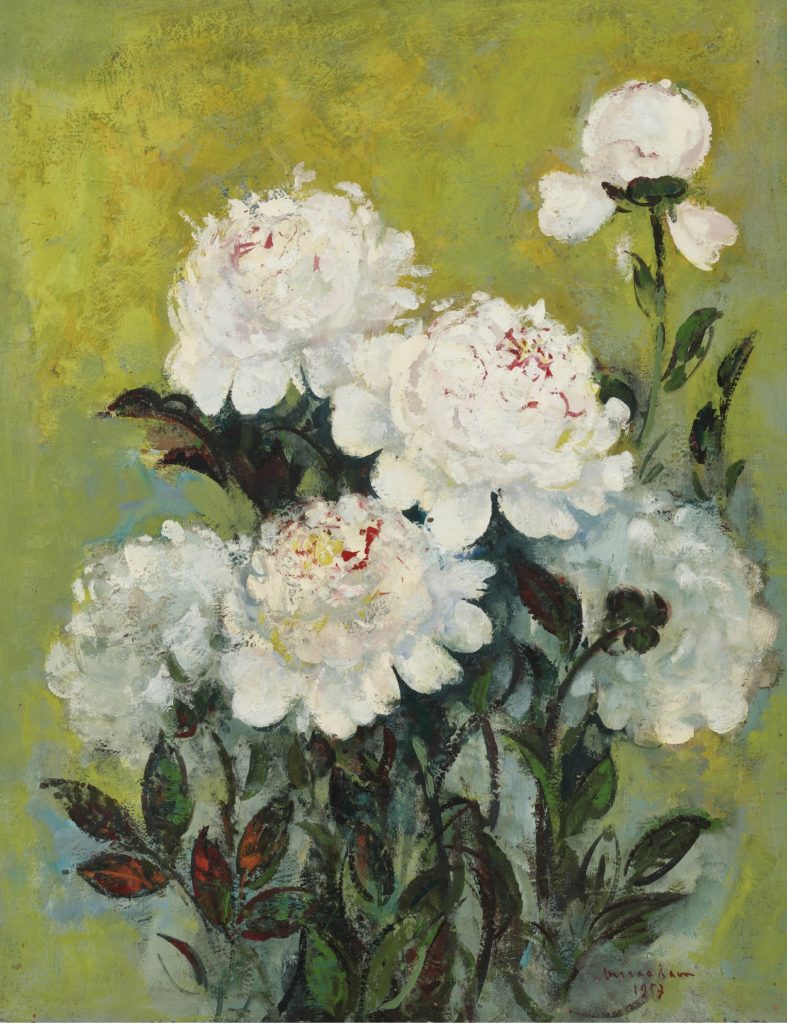Vu Cao Dam, “Pivoines”, 1957 or the memory to live
” Pivoines” (peonies) is a rare work, an oil on panel (65×50 cm) created at a crucial moment in the painter’s life, which provides us with information about his particular technique and philosophy.

I. The rare work of a soothed man and a stimulated artist
A. A rare work :
Vu Cao Dam painted few flowers in his work, preferring to depict human or mythical beings, divinities, and occasionally animals (roosters, horses, etc.) Besides peonies, he also painted chrysanthemums, gladioli, lilies, and poppies.
B. A soothed man and a stimulated artist:
He loved the town of Vence, where he settled with his family from Béziers in July 1952.
Brilliant artists pervaded the atmosphere, from Matisse and his chapel (completed in 1951) to Chagall, his neighbour and friend, among others.
His health improved, as did the health of his son Michel.
The Vietnam War, which had worried him so much, ended 3 years earlier.
Collectors were more numerous. The same year, 1957, he exhibited at La Chaux de Fonds and Langenthal in Switzerland.
Soothed, Vu Cao Dam was also stimulated.
Although his previous years had been fruitful in terms of research into pigments (including the use of Caparol), different materials and even the reflection of the glass covering his gouaches and ink on silk, the newfound peace and quiet and the artistic atmosphere of the place encouraged his creativity. An excellent example of this is his ‘Bouquet of Flowers’, for which Vu Cao Dam used oil. This was the medium he used throughout his contract with the Wally Findlay Gallery from 1963.
II. A unique technique and approach to the world
A. A unique technique :
Le Pho, his classmate and lifelong friend, wanted freshly cut flowers, usually of different species, and usually placed them in a vase, which is an important element in the composition of the painting. As is the table on which the vase is placed, or the various objects (books, magazines, ceramics, fabrics, etc.) arranged around it.
Here, with Vu Cao dam, there are no vases, not even soil. No objects around. No table or decorations.
Just the flowers. Peonies, nothing else.
Served with an original technique. The artist placed the flowers one by one in different bottles, so that each one appeared to be alive, unlike the bouquet, which was actually a dead plant.
Of course, we must see in this the sensibility of the great sculptor that he was, not satisfied with the limits of the two dimensions of painting and always in search of the third dimension of sculpture, but we can also see in it the affirmation of a philosophy.
B. A philosophy of rediscovered time
« My father had a great artistic culture. When he was a student, he had a card from the Ecole du Louvre that gave him free access to the Guimet Museum and the Louvre Museum » commented Michel Vu, the artist’s son (private communication, 18 October 2024).
A great reader and a great visitor with a rare erudition, Vu Cao Dam could not have overlooked the ‘Carnation Flowers’, an ink and colours on silk from 1314 by Qian Xuan (1235- circa 1300-1305) in the Musée Guimet and the oil on canvas from 1640 by Jan Davidz De Heem (1606-1684) ‘The Dessert’ in the Musée du Louvre. Vu Cao Dam is sensitive to the desire of the former, faithful to the great Chinese tradition, to ‘take part in the very “gestures” of Creation’ (François Cheng), and to the expression of the latter, champion of a European genre combining the fleetingness of life, luxury and (sometimes) exoticism. Vu Cao Dam himself wanted to give his flowers a ‘breath of fresh air’ and considered any setting to be superfluous.
The background is non-uniform, with bright touches of aqua green and light blue at the bottom of the work, fading to ochre yellow at the top. Green, black and red foliage supports vivid, powerful flowers.
Seductresses feigning immortality.
Exalting life and love, making death a memory to be lived.
Time rediscovered.
Elegantly.
Jean-François Hubert